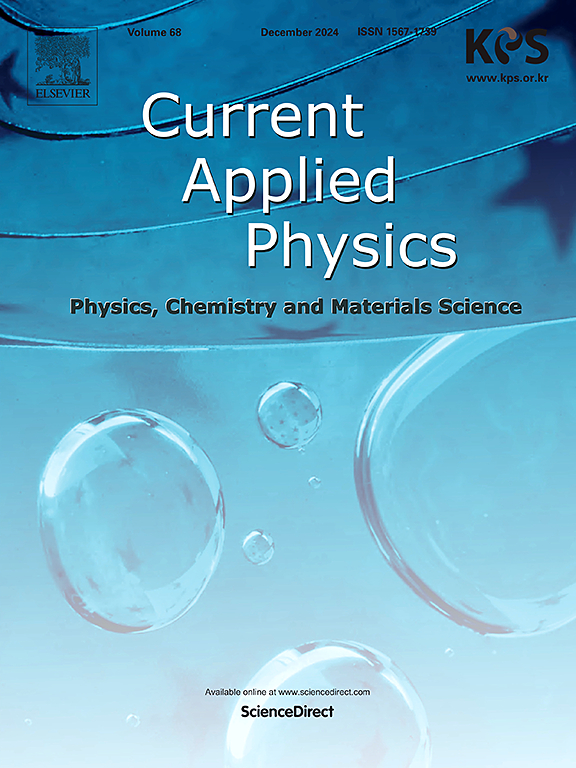Enhancing photovoltaic performance of flower-like MoS2@ZnO core-shell nanowire photoanodes: Synergistic effects on solar energy conversion
IF 3.1
4区 物理与天体物理
Q3 MATERIALS SCIENCE, MULTIDISCIPLINARY
引用次数: 0
Abstract
This study introduces an innovative flower-like molybdenum sulfide (MoS2)-doped zinc oxide (ZnO) core-shell nanowire (NWs) designed to enhance the efficiency of dye-sensitized solar cells (DSSCs). The MoS2@ZnO NWs, created via a simple hydrothermal method, exhibit flower-like structures that improve light absorption and charge separation. Surface morphology analyses using FE-SEM, HR-TEM, and AFM confirm the core-shell architecture of the NWs, while XRD patterns reveal a hexagonal wurtzite phase with a distinct (003) plane. Electrical conductivity studies show that MoS2@ZnO NWs achieve a high conductivity of 3.65 × 10−3 S cm−1. DSSCs were assembled with ZnO NPs and MoS2@ZnO NWs as photo-anodes and iodide/tri-iodide redox mediator solution, along with platinum (Pt) as the counter electrode (CE). The MoS2@ZnO photo-anode attained a promising efficiency of 7.25 %, compared to 4.07 % from pristine ZnO NPs, highlighting the potential of core-shell NWs for advanced solar Cell applications.

提高花状MoS2@ZnO核壳纳米线光电阳极的光伏性能:对太阳能转换的协同效应
本研究介绍了一种创新的花状硫化钼(MoS2)掺杂氧化锌(ZnO)核壳纳米线(NWs),旨在提高染料敏化太阳能电池(DSSCs)的效率。MoS2@ZnO NWs是通过简单的水热法创造的,呈现出花状结构,可以改善光吸收和电荷分离。利用FE-SEM、HR-TEM和AFM对NWs的表面形貌进行分析,证实了NWs的核壳结构,而XRD谱图则显示了具有明显(003)平面的六方纤锌矿相。电导率研究表明,MoS2@ZnO NWs具有3.65 × 10−3 S cm−1的高电导率。DSSCs以ZnO NPs和MoS2@ZnO NWs作为光阳极和碘化物/三碘化物氧化还原介质溶液,铂(Pt)作为反电极(CE)组装。MoS2@ZnO光阳极的效率为7.25%,而原始ZnO NPs的效率为4.07%,突出了核壳NWs在先进太阳能电池应用中的潜力。
本文章由计算机程序翻译,如有差异,请以英文原文为准。
求助全文
约1分钟内获得全文
求助全文
来源期刊

Current Applied Physics
物理-材料科学:综合
CiteScore
4.80
自引率
0.00%
发文量
213
审稿时长
33 days
期刊介绍:
Current Applied Physics (Curr. Appl. Phys.) is a monthly published international journal covering all the fields of applied science investigating the physics of the advanced materials for future applications.
Other areas covered: Experimental and theoretical aspects of advanced materials and devices dealing with synthesis or structural chemistry, physical and electronic properties, photonics, engineering applications, and uniquely pertinent measurement or analytical techniques.
Current Applied Physics, published since 2001, covers physics, chemistry and materials science, including bio-materials, with their engineering aspects. It is a truly interdisciplinary journal opening a forum for scientists of all related fields, a unique point of the journal discriminating it from other worldwide and/or Pacific Rim applied physics journals.
Regular research papers, letters and review articles with contents meeting the scope of the journal will be considered for publication after peer review.
The Journal is owned by the Korean Physical Society.
 求助内容:
求助内容: 应助结果提醒方式:
应助结果提醒方式:


